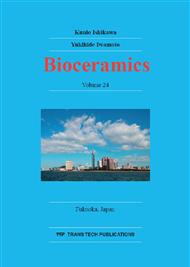p.217
p.223
p.229
p.233
p.237
p.243
p.247
p.251
p.255
Formation of Hydroxyapatite on Nickel-Free High-Nitrogen Stainless Steel by Chemical Solution Deposition Method in Neutral/Alkaline Solution
Abstract:
Calcium phosphate (CaP) was formed on glutamic acid-modified nickel-free high-nitrogen stainless steel (HNS) by a chemical solution deposition method in neutral/alkaline solution. Modification of glutamic acid on the surface of HNS was performed using trisuccinimidyl citrate (TSC) as a linker. The glutamic acid-derived carboxyl groups introduced on HNS initiated rapid nucleation of CaP during each treatment at pH 7.3 or 8.9. X-ray diffraction analysis and Fourier transform infrared spectra showed each CaP deposited on glutamic acid-immobilized HNS after 24 hrs was identified as low-crystallinity calcium-deficient carbonate-containing hydroxyapatite (HAp). A significant difference in the microstructure between the two pH values was observed; HAp deposited at pH 7.3 was composed of plate-like crystals, whereas that at pH 8.9 was chestnut-like crystals. Therefore, the pH value of the solution played an effective role in controlling the microstructure of HAp deposited on glutamic acid-immobilized HNS.
Info:
Periodical:
Pages:
237-242
Citation:
Online since:
November 2012
Price:
Сopyright:
© 2013 Trans Tech Publications Ltd. All Rights Reserved
Share:
Citation:


